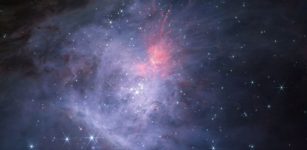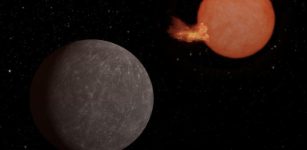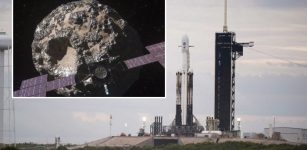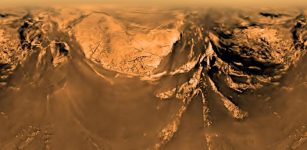New Findings Change How Vesta Is Defined As Not Quite An Asteroid Or A Planet
Eddie Gonzales Jr. – MessageToEagle.com – For decades, scientists have suggested that Vesta, a major body in the asteroid belt, is more than just an asteroid. Research shows Vesta has a crust, mantle, and core—key planetary features. Astronomers study Vesta to understand early planet development and hypothesize about Earth’s formative years.
Vesta is a colorful world; craters of a variety of ages make splashes of lighter and darker brown against its surface. This photo was processed from data acquired on July 24, 2011, from a distance of about 5200 kilometers, during the third “rotation characterization” observation by Dawn. Image credit: NASA / JPL / MPS / DLR / IDA / Björn Jónsson – Public Domain
In a new paper, Michigan State University’s researchers reveal that Vesta’s interior structure is more uniform than previously thought. These findings startled researchers who, until then, assumed Vesta was a protoplanet that never grew to a full planet.
“The lack of a core was very surprising,” said MSU Earth and Environmental Sciences Assistant Professor Seth Jacobson, a co-author on the paper. “It’s a really different way of thinking about Vesta.”
What is Vesta’s true identity? The research team has two hypotheses that need further exploration.
The first possibility is Vesta went through incomplete differentiation, meaning it started the melting process needed to give the asteroid distinct layers, like a core, mantle and crust, but never finished. The second is a theory Jacobson floated at an astronomy conference years ago — Vesta is a broken chunk off a growing planet in our solar system.
At the conference, Jacobson wanted other researchers to consider the possibility that some meteorites could be debris from collisions that took place during the planet formation era. He included Vesta in his suggestion but hadn’t considered it a real possibility.
“This idea went from a somewhat silly suggestion to a hypothesis that we’re now taking seriously due to this re-analysis of NASA Dawn mission data,” Jacobson said.
More than an asteroid
Most asteroids consist of ancient chondritic material, resembling cosmic sedimentary gravel. In contrast, Vesta’s surface features volcanic basaltic rocks, indicating it underwent planetary differentiation, with metal sinking to form a core.
NASA launched the Dawn spacecraft in 2007 to study Vesta and Ceres in the asteroid belt and understand planet formation. Dawn orbited Vesta from 2011 to 2012, mapping its surface with high-resolution images. It performed similar tasks at Ceres before concluding in 2018, when scientists published the findings.
Jacobson said the more that researchers used the data, the better they got at processing it. They found ways to more accurately calibrate measurements that yield an improved picture of Vesta’s makeup. That’s why Ryan Park, a JPL senior research scientist and principal engineer, and his team decided to reprocess Vesta’s measurements.
“For years, conflicting gravity data from Dawn’s observations of Vesta created puzzles,” Park said. “After nearly a decade of refining our calibration and processing techniques, we achieved remarkable alignment between Dawn’s Deep Space Network radiometric data and onboard imaging data. We were thrilled to confirm the data’s strength in revealing Vesta’s deep interior. Our findings show Vesta’s history is far more complex than previously believed, shaped by unique processes like interrupted planetary differentation and late-stage collisions.”
Planetary scientists estimate a celestial body’s core size by measuring its moment of inertia, a physics concept about changing an object’s rotational speed. Jacobson compares it to a figure skater who speeds up by pulling their arms in and slows down by extending them, altering their moment of inertia.
An object in space with a larger core behaves like a ballerina with arms pulled in. Celestial bodies with dense cores move differently. Using this knowledge, the research team measured Vesta’s rotation and gravity field. The results showed Vesta didn’t behave like an object with a core, challenging previous formation theories.
Two hypotheses
Neither hypothesis has been explored enough to rule either out, but both have problems that require more research to explain. While incomplete differentiation is possible, it doesn’t line up with the meteorites researchers have collected over time.
“We’re really confident these meteorites came from Vesta,” Jacobson said. “And these don’t show obvious evidence of incomplete differentiation.”
The alternative explanation is based on the idea that as the terrestrial planets formed, large collisions occurred, mostly growing the planets but also generating impact debris. The ejected materials from those collisions would include rocks resulting from melting, and, like Vesta, they wouldn’t have a core.
Jacobson’s lab was already exploring the consequences of giant impacts during the planet formation era. He’s working with one of his graduate students, Emily Elizondo, on the idea that some asteroids in the asteroid belt are pieces ejected from the growing planets.
This idea is still far from proven. More models need to be created and fine-tuned to prove that Vesta is an ancient chunk of a forming planet. Scientists can adjust how they study Vesta meteorites to dive deeper into either hypothesis, Jacobson said. They could also do further studies with the new approaches to the Dawn mission data.
This paper is only the beginning of a new direction of study, Jacobson said. It could forever change how scientists look at differentiated worlds.
“No longer is the Vesta meteorite collection a sample of a body in space that failed to make it as a planet,” Jacobson said. “These could be pieces of an ancient planet before it grew to full completion. We just don’t know which planet that is yet.”
Source – Michigan State University – via Eurekalert
Written by Eddie Gonzales Jr. – MessageToEagle.com Staff Writer











